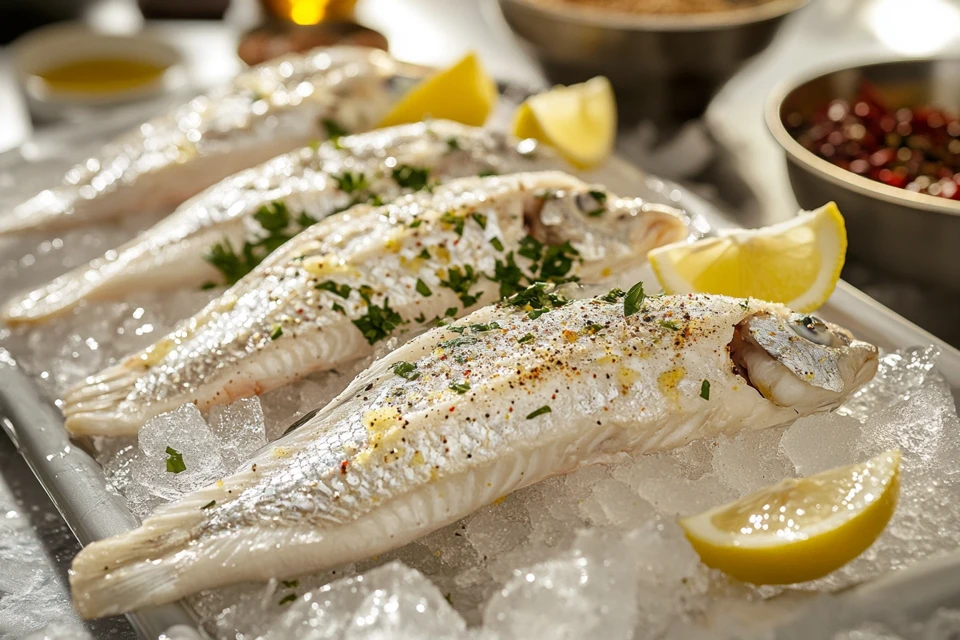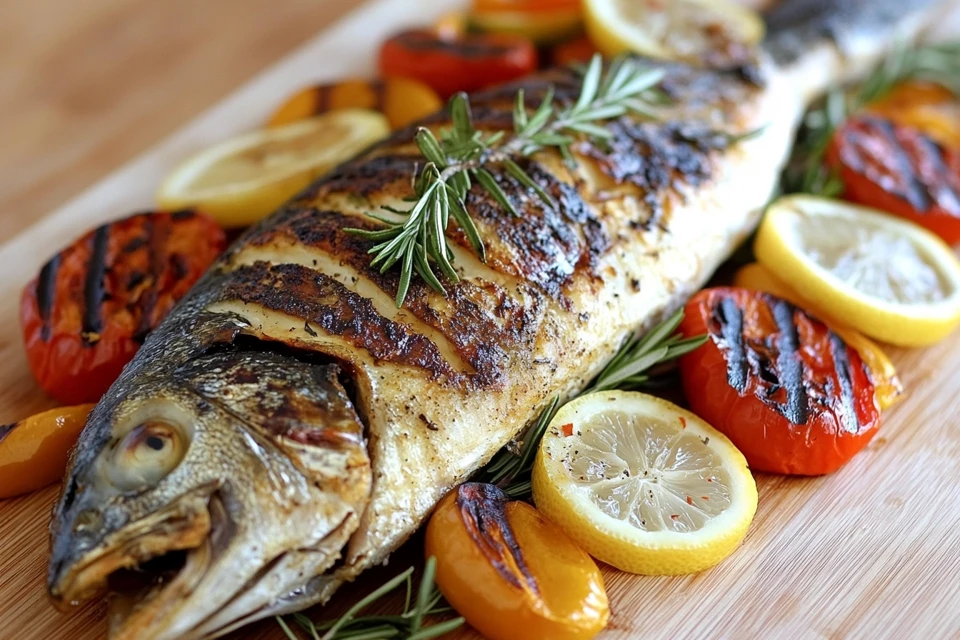1. Introduction
Do you eat the skin of branzino? Branzino, often referred to as European sea bass, has earned its reputation as a culinary favorite worldwide. Known for its mild flavor and delicate texture, this Mediterranean fish is frequently served whole or as fillets in upscale restaurants and home kitchens.
However, one question often arises when preparing this fish “Do you eat the skin of branzino?” Many seafood enthusiasts and chefs highlight the crispy, flavorful skin as one of the best parts of the fish, but others wonder about its safety, nutritional value, and texture.
This article delves into the topic in detail, examining whether branzino skin is edible, its nutritional benefits, and the best ways to cook and enjoy it. We’ll also address sustainability concerns and common misconceptions to help you make an informed decision.
2. What is Branzino: Do You Eat the Skin of Branzino?
To answer do you eat the skin of branzino, it’s important to first understand what this fish is, its origins, and its culinary significance. Branzino is prized not only for its flavor but also for its versatility, including its edible skin.
2.1 Branzino Overview: What Makes It Popular?
Branzino, also known as European sea bass, is a saltwater fish commonly found in the Mediterranean Sea and parts of the Atlantic Ocean. Learn more about its origin and characteristics in our detailed article on What Kind of Fish is Branzino?.
Key Features of Branzino:
- Size: Typically weighs between 1-3 pounds, making it ideal for serving whole.
- Appearance: Shiny silver scales, a sleek shape, and a firm texture.
- Versatility: Suitable for grilling, baking, steaming, and pan-searing.
Its skin, in particular, becomes crispy when cooked, leading many to consider it a highlight of the dish. But do you eat the skin of branzino? The following sections explain why the skin is often enjoyed.
2.2 Nutritional Profile: Is Branzino Skin Healthy to Eat?
Branzino skin isn’t just edible—it’s packed with nutrients that contribute to a balanced diet.
Nutritional Highlights:
- Protein-Rich: Supports muscle repair and growth.
- Omega-3 Fatty Acids: Promote heart and brain health while reducing inflammation.
- Collagen: Beneficial for skin elasticity and joint health.
- Minerals: Includes selenium and phosphorus, essential for immunity and bone strength.
Eating the skin enhances the overall nutritional value, making branzino not only tasty but also healthy and beneficial.
2.3 Texture and Taste of Branzino Skin
The texture of branzino skin is a key reason many chefs and seafood lovers prefer leaving it on during preparation.
Flavor and Texture Benefits:
- Crispy Skin: Achieved through grilling or pan-searing, adding a satisfying crunch.
- Flavor Enhancer: Locks in moisture, keeping the flesh tender and flavorful.
- Absorbs Seasonings: Complements marinades and spices, elevating the overall taste.
While some may prefer removing the skin for a softer texture, those who enjoy a crispy bite often keep it intact.
3. Is Branzino Skin Safe to Eat?
Many people ask, do you eat the skin of branzino, and a primary concern revolves around safety. Fish skin, including branzino’s, can be completely safe to consume if prepared and sourced properly. Let’s address the safety factors and considerations.
3.1 Food Safety Concerns: Do You Eat Branzino Skin Without Risk?

Branzino skin is generally safe to eat as long as it’s cleaned and cooked properly. The cooking process eliminates most bacteria and parasites that may exist on raw fish.
Key Safety Tips:
- Freshness Matters: Always select fresh branzino with clear eyes, firm flesh, and no fishy odor.
- Proper Cleaning: Scale and rinse the skin thoroughly to remove any debris or impurities.
- Cooking Temperature: Cook the fish to an internal temperature of 145°F (63°C) to kill harmful pathogens.
Fact Check: Many chefs recommend branzino skin as safe and nutritious when properly prepared.
3.2 Common Risks Associated with Eating Fish Skin
Despite its benefits, some people worry about contaminants, especially in farmed fish. Do you eat the skin of branzino safely in terms of heavy metals and toxins?
Key Considerations:
- Low Mercury Levels: Branzino is classified as a low-mercury fish, making it safer than larger predatory fish like tuna or swordfish.
- Farmed vs. Wild: Farmed branzino may contain traces of antibiotics or pesticides if not sourced from reputable farms. Choose certified sustainable options whenever possible.
- Source Verification: Look for labels like MSC (Marine Stewardship Council) or ASC (Aquaculture Stewardship Council) to ensure ethical and clean farming practices.
Takeaway: Branzino skin is safe to eat, especially when sourced from trusted suppliers.
3.3 Allergies and Sensitivities: Do You Eat Branzino Skin if You Have Allergies?
Fish allergies are common, but they typically involve proteins found in the flesh rather than the skin. However, sensitive individuals should proceed with caution.
Key Tips for Allergy Management:
- Test First: Try a small portion of cooked branzino skin to check for reactions.
- Avoid Raw Skin: Cooking reduces potential allergens and contaminants.
- Consult a Doctor: If you have existing seafood allergies, consult a specialist before trying fish skin.
Final Thought: For most people, branzino skin is not only safe but also a flavorful and nutritious addition to their diet.
4. Nutritional Benefits of Eating Branzino Skin
Beyond its flavor and texture, branzino skin offers significant nutritional benefits. For those asking do you eat the skin of branzino to improve health, the answer lies in its rich nutrient profile. Let’s explore why keeping the skin on can be a smart dietary choice.
4.1 Omega-3 Fatty Acids: Is Branzino Skin a Healthy Source?
Branzino skin is packed with omega-3 fatty acids, which play a critical role in maintaining overall health.
Health Benefits of Omega-3s in Branzino Skin:
- Heart Health: Reduces inflammation and improves cholesterol levels.
- Brain Function: Supports cognitive performance and mental health.
- Joint Support: Helps reduce stiffness and swelling in arthritis sufferers.
Comparison: While branzino doesn’t contain as much omega-3 as salmon, it provides a lighter option with sufficient healthy fats for daily needs.
4.2 Collagen and Skin Health: Do You Eat Branzino Skin for Beauty Benefits?
Collagen, abundant in fish skin, is a protein known for promoting healthy skin, hair, and joints.
Why Collagen Matters:
- Anti-Aging Properties: Improves skin elasticity and hydration, reducing fine lines.
- Joint Support: Strengthens cartilage and connective tissues, reducing joint pain.
- Wound Healing: Supports skin regeneration and repair.
By consuming branzino skin, you can naturally boost collagen intake, making it a beauty-enhancing addition to your diet.
4.3 Protein and Minerals: Is Branzino Skin Nutritionally Balanced?
Branzino skin also delivers lean protein and essential minerals, which support muscle growth and overall well-being.
Key Nutrients in Branzino Skin:
- Protein: Aids in muscle repair and energy production.
- Selenium: Acts as an antioxidant, protecting cells from damage.
- Phosphorus: Supports bone health and energy metabolism.
- Vitamin B12: Improves nerve function and red blood cell production.
Quick Tip: Eating the skin maximizes the nutrient intake, as peeling it removes some of these health benefits. For another protein-rich dish, you might enjoy this Sinigang Recipe, packed with flavor and nutrients.
4.4 Caloric and Fat Content: Does Branzino Skin Fit a Healthy Diet?
Branzino skin is low in calories and high in healthy fats, making it suitable for most diets.
Key Dietary Insights:
- Calories: Around 125 calories per serving, ideal for low-calorie diets.
- Healthy Fats: Provides monounsaturated fats that support heart health.
- Low in Carbs: Perfect for keto and low-carb meal plans.
Conclusion: Whether for fitness goals, skin health, or general well-being, branzino skin is a nutrient-packed option that’s easy to incorporate into any diet.
5. Culinary Tips: How to Prepare and Cook Branzino Skin?
Many people ask, do you eat the skin of branzino in its natural state, or should it be cooked first? The answer often depends on personal preference, but most experts agree that crispy branzino skin is the best way to enjoy it. In this section, we’ll explore preparation techniques and cooking tips to bring out the best in branzino skin.
5.1 Cooking Methods for Crispy Branzino Skin—Do You Eat It Pan-Seared or Grilled?

Branzino skin shines when it’s crispy and golden brown. Here are the top methods for achieving that perfect texture:
1. Pan-Searing:
- Steps:
- Pat the fish skin completely dry with paper towels.
- Heat olive oil in a non-stick skillet over medium-high heat.
- Place the fish skin-side down and press gently with a spatula to prevent curling.
- Cook until the skin is crisp (about 3–4 minutes) before flipping briefly to finish cooking the flesh.
2. Grilling:
- Steps:
- Lightly oil the skin to prevent sticking.
- Preheat the grill to medium-high heat.
- Grill the fish skin-side down until crispy and slightly charred.
3. Baking:
- Steps:
- Brush the skin with olive oil and season with salt and pepper.
- Bake at 400°F for 15–20 minutes until golden and crispy.
4. Broiling:
- Perfect for quick cooking while achieving crispiness in minutes.
5.2 Cleaning and Prepping Branzino Skin—Do You Eat It After Scaling?
Before cooking branzino skin, proper preparation ensures the best texture and flavor.
Cleaning Steps:
- Scaling: Use a fish scaler or the back of a knife to remove scales. Rinse thoroughly under cold water.
- Drying: Pat dry to ensure crispiness during cooking.
- Trimming: Remove fins or any loose parts that may burn.
Pro Tip: Leaving the skin intact preserves moisture during cooking and enhances presentation.
5.3 Recipes Featuring Branzino Skin—Do You Eat It With Marinades or Plain?
1. Mediterranean Grilled Branzino with Lemon and Herbs
- Ingredients: Branzino, olive oil, garlic, rosemary, thyme, and lemon slices.
- Instructions: Grill whole branzino with herbs tucked inside and brush with garlic-infused olive oil for flavor.
2. Pan-Seared Branzino Fillets with Garlic Butter Sauce
- Ingredients: Branzino fillets, butter, garlic, parsley, and lemon juice.
- Instructions: Sear the skin-side first for crispiness, then top with a drizzle of garlic butter sauce for added richness.
3. Asian-Inspired Steamed Branzino with Ginger and Soy Sauce
- Ingredients: Branzino, soy sauce, sesame oil, ginger, and scallions.
- Instructions: Steam the fish until tender, then pour a hot soy-based sauce over the skin for flavor infusion.
For more ideas, check out this Branzino Recipe Guide for step-by-step instructions and tips.
6. Environmental Considerations: Is Eating Branzino Skin Sustainable?
As seafood lovers grow more eco-conscious, sustainability plays a major role in food choices. When asking whether branzino is a sustainable option, it’s important to consider farming practices, sourcing, and environmental impacts.
6.1 Farmed vs. Wild-Caught Branzino
The majority of branzino available in markets today is farmed, which helps reduce pressure on wild populations.
Sustainability Highlights:
- Farmed Branzino: Produced in controlled environments, reducing overfishing risks.
- Wild-Caught Branzino: Highly regulated to prevent depletion but less common due to cost and availability.
Consumers should prioritize responsibly farmed branzino or look for wild-caught options certified by sustainability organizations like MSC or ASC.
6.2 Reducing Waste by Eating Fish Skin
Consuming the skin is not only flavorful but also reduces food waste, aligning with sustainable cooking practices.
Benefits of Whole-Fish Cooking:
- Less Waste: Eating the skin minimizes discarded parts.
- Resource Efficiency: Utilizing the entire fish supports ethical food consumption.
For eco-conscious consumers, incorporating fish skin into meals helps reduce kitchen waste while maximizing nutrition.
7. FAQs About Eating Branzino Skin
Here are some frequently asked questions about whether branzino skin is safe, healthy, and enjoyable to eat.
7.1 Can you eat the skin of branzino?
Yes, branzino skin is edible and highly nutritious. It becomes crispy and flavorful when cooked properly, making it a favorite among chefs and seafood enthusiasts.
7.2 Is branzino skin healthy?
Absolutely! Branzino skin is rich in omega-3 fatty acids, collagen, and minerals like selenium and phosphorus, all of which support heart health, skin elasticity, and muscle growth.
7.3 How do you make branzino skin crispy?
For crispy skin, pat the fish dry, season it, and cook it skin-side down in a hot, oiled pan. Press gently with a spatula to keep it flat and evenly crisp.
7.4 Should you remove the skin before cooking?
No, it’s not necessary to remove the skin unless you prefer a softer texture. Cooking the fish with the skin on retains moisture and adds flavor.
7.5 Does branzino skin contain mercury?
Branzino is classified as a low-mercury fish, making it safe for regular consumption, including for pregnant individuals and children.
8. Conclusion
So, do you eat the skin of branzino? The answer is a resounding yes—for most people. Branzino skin is not only safe to eat but also offers a range of nutritional benefits, including omega-3 fatty acids, collagen, and essential minerals that promote overall health.
Its versatility in cooking, whether grilled, pan-seared, or baked, makes it an excellent option for those who enjoy crispy textures and rich flavors. Additionally, eating the skin supports sustainable practices by reducing food waste and maximizing the use of the whole fish.
For those who prioritize health-conscious eating, branzino provides a low-mercury seafood option packed with nutrients. Whether you’re cooking a quick weeknight meal or preparing an elegant dinner, keeping the skin on branzino can elevate your dish both in flavor and presentation.
So, next time you’re preparing branzino, give its crispy, flavorful skin a try—you won’t be disappointed!
